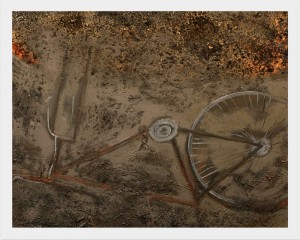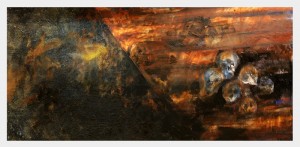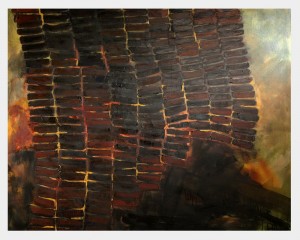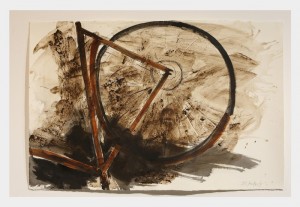Talamh Dóite - Fired Ground

Talamh Dóite
Seán Ó Flaithearta
Má théann tú ag siúl ar an bportach san earrach feicfidh tú agus mothóidh tú plandaí agus bláthanna ag fás, agus cloisfidh tú ceiliúr na n-éan sa scrobarnach faoi do chosa agus go hard os do chionn. Nuair a chuirtear lasóg na creiche leis an talamh lena dhó bíonn an portach ina thost; ciúnas i ndiaidh anfa. Ní bhíonn fágtha ach an tírdhreach dúloiscthe, gan a éide fód. Bíonn cruth an talaimh le feiceáil, tarnocht faoi chlóca uaigneach dúchiúnais. Bíonn an saol ina stad.
Bíonn teacht ar earraí agus ar shlite maireachtála a bhí faoi cheilt le cúpla glúin siar, nochtar claíocha cuibhreann, aiséiríonn smionagar tithe as patrúin dhubha na dtrinsí iompaithe, bachtaí móna a gearradh agus a baineadh le sleán anaithnid. Gréithe cistine a úsáideadh le líon tí a chothú, i bhfad siar, caite le taobh gréithe eile nach bhfuil ann ach le seal. Nochtar seanrothair high nelly, ag meabhrú dúinn gurbh é an capall iarainn a rialaigh rithim an tsaoil tráth.
Fágann an coirloscadh gan éifeacht seo páirc áir mar a mbíodh tírdhreach docheansaithe, aithris mhaoithneach ar shean-nósanna feirmeoireachta leis an talamh a ghlanadh. Faightear léargas sa slad gan chéill ar an tírdhreach ar chumas foréigin an duine agus ar an mí-úsáid a bhaineann sé as an gcumhacht a mhothaíonn sé atá aige. Is gníomh cogaidh é an chré a dhó. Beatha a ruaigeadh, gortghlanadh ar neacha beo.
Déantar machnamh sa taispeántas seo ar an ngaol atá againn leis an timpeallacht agus an méid a bheimis sásta a dhéanamh le cead ár gcinn a fháil. Dírítear sa saothar ar a mbíonn fágtha i ndiaidh an áir. Bíonn an tírdhreach apacailipteach mar a bheadh scáthán ann ar ár nádúr daonna.
Baineadh úsáid as amhábhair as an bportach féin, mar théama agus mar mheán ar féidir lámh a leagan air, i bpróiseas cruthaithe na saothar seo le freagra níos pearsanta a thabhairt ar an gcaoi a gcuirtear talamh ar thine.
Fired Ground
Seán Ó Flaithearta
The annual practice of burning bog land to clear the ground is the starting point of this new collection of visual art works. It brings together local and international themes of warlike destructiveness. By working with the bog, both as a subject and as a medium, the raw elements have been incorporated into the creative process to give a closer and tactile response to the burning of the land. The fired ground exposes layers of history, time and meaning; a palimpsest of the potential of the human condition.
When you walk in the bog at springtime you can see, feel and smell the growth of plants and flowers and you hear the song of birds from the undergrowth and high in the sky. After the land is fired in an act of destruction and vandalism the bog land becomes silent. What is revealed is a deathly black landscape stripped of all its natural clothing. You can view the land’s naked contour in its eerie silent blackish beauty. It is a place where life has stopped.
Objects and ways of living are revealed which may have been hidden away for generations, walls of fields are exposed, fragments of homes appear from the black, lazy bed patterns in the ground, bogs marked and cut by some unknown sleán. Kitchen utensils, once used to prepare food for a family, beside some castaways from more recent memories. High Nellies reveal themselves, reminding us of a time when the pace of life was measured by the bicycle.
A warlike wilderness covers an untameable landscape in the wasteful futility of the slash and burn method of destruction, in some sentimental recounting of old farming methods when controlled burning was common practice. Man’s violence and abuse of his sense of power is amplified in this senseless devastation. The burning of our earth is an act of war, leaving a place without life, a clearance of living things.
The work considers our relationship with the environment and what we are prepared to do to impose our will. The aftermath and what is presented to us is the focus of this collection of work. The apocalyptic landscape left behind is a mirror of our human nature.











